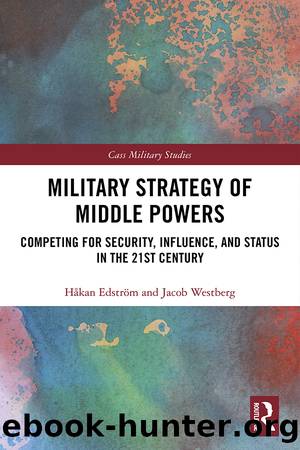Military Strategy of Middle Powers by Håkan Edström Jacob Westberg

Author:Håkan Edström, Jacob Westberg [Håkan Edström, Jacob Westberg]
Language: eng
Format: epub
Tags: History, Military, Strategy, General, Political Science, Security (National & International), International Relations, Political Freedom
ISBN: 9781000204667
Google: ucP4DwAAQBAJ
Publisher: Routledge
Published: 2020-10-15T01:39:16+00:00
Another concern of the Australian government was that most countries in Australiaâs immediate neighbourhood were perceived to be facing large economic and structural challenges. In 2003, just a few years after the white paper was released, the Australian government admitted that there was no doubt that the strategic landscape had changed. Terrorism and increased concerns about the proliferation of WMD now dominated the elaborations. At the same time, the government argued, strategic competition between states had not gone away. Even if the relations amongst major power generally had become more stable, strategic competition between the US and China was expected to continue. In this regard, the government warned that the risk of miscalculation over Taiwan persisted. Moreover, the government suggested that a potential social breakdown within China could worsen this even further. In addition, the potential for conventional military conflict was considered to remain in North Asia. The government concluded that the Korean peninsula continued to be a potential flashpoint, and that North Koreaâs nuclear ambitions could escalate the situation. Even if the risks of a direct military attack on Australia was considered to be lower compared to the situation in 2000, new threats were identified. Anti-Americanism, rogue states, and regional Southeast Asian extremist organisations were all contributing to these new aspects of the international environment, the government analysed. âPeople smuggling, illegal fishing and money laundering feed off and exacerbate existing difficulties. Corruption, population and environmental pressures add to the troubles.â Together, these challenges left Australiaâs closest neighbours âvulnerable to transnational threatsâ the government stressed (Australian DoD 2003:18â19). For this reason, East Timor, Indonesia, Papua New Guinea, and the Pacific Island states were given extra attention in the analysis.
Southeast Asia and the South Pacific face major challenges due to political weakness, decline in governance, difficulty in grappling with terrorism and the economic effects of terrorism. If these trends continue, there may be increased calls [on the Australian Defence Forces] for operations in Australiaâs immediate neighbourhood.
(Australian DoD 2003:23)
Download
This site does not store any files on its server. We only index and link to content provided by other sites. Please contact the content providers to delete copyright contents if any and email us, we'll remove relevant links or contents immediately.
The Secret History by Donna Tartt(18798)
The Social Justice Warrior Handbook by Lisa De Pasquale(12118)
Thirteen Reasons Why by Jay Asher(8762)
This Is How You Lose Her by Junot Diaz(6746)
Weapons of Math Destruction by Cathy O'Neil(6110)
Zero to One by Peter Thiel(5657)
Beartown by Fredrik Backman(5571)
The Myth of the Strong Leader by Archie Brown(5397)
The Fire Next Time by James Baldwin(5220)
How Democracies Die by Steven Levitsky & Daniel Ziblatt(5107)
Promise Me, Dad by Joe Biden(5068)
Stone's Rules by Roger Stone(5008)
100 Deadly Skills by Clint Emerson(4819)
A Higher Loyalty: Truth, Lies, and Leadership by James Comey(4819)
Rise and Kill First by Ronen Bergman(4677)
Secrecy World by Jake Bernstein(4615)
The David Icke Guide to the Global Conspiracy (and how to end it) by David Icke(4596)
The Farm by Tom Rob Smith(4417)
The Doomsday Machine by Daniel Ellsberg(4390)
